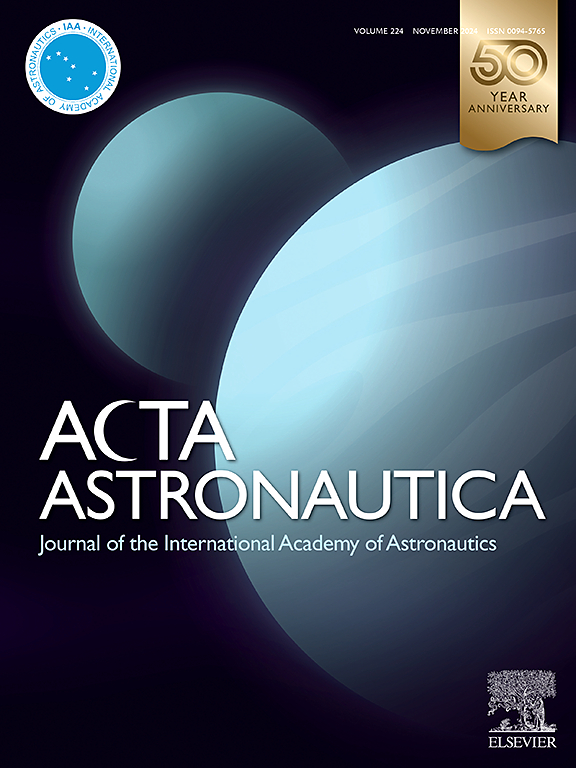Joint acceleration based adaptive reactionless manipulation of closed-loop multi-arm space robot in post-capture phase
IF 3.1
2区 物理与天体物理
Q1 ENGINEERING, AEROSPACE
引用次数: 0
Abstract
Space robots will play a crucial role in on-orbit operations like refuelling, servicing, and capture of debris. This paper focuses on capturing a non-cooperative target using a multi-arm space robot and its post-capture control. In the post-capture phase, a target object gets rigidly attached to end-effectors, and arms get into a closed-loop configuration, resulting in added constraints. Further, due to a target object’s unknown inertial parameters, system behaviour becomes unpredictable and poses difficulty in achieving reactionless manipulation to minimize base attitude disturbance. We present acceleration-based adaptive reactionless manipulation in the post-capture phase considering the unknown inertial parameter of a target. The regressor form required for adapting the joint states is derived using the acceleration-based approach. To update unknown parameters recursively immediately after impact, three methods, namely, recursive least square (RLS), weighted recursive least square (WRLS), and Kalman filter (KF), are used and compared. The efficacy of these methods has been demonstrated by using numerical studies of a dual-arm space robot that captures a non-cooperative target. Further, the acceleration-based and the velocity-based approaches are individually compared with RLS, WRLS and KF methods. Investigations have also been carried out to study the effects of change in ratios of base-to-target and base-to-robot masses, as well as angular velocities of a target.
基于联合加速度的闭环多臂空间机器人后捕捉阶段自适应无反作用力操纵
空间机器人将在加油、维修和捕获碎片等在轨操作中发挥至关重要的作用。本文的重点是使用多臂太空机器人捕获非合作目标及其捕获后控制。在捕获后阶段,目标物体被刚性连接到末端执行器上,手臂进入闭环配置,从而增加了限制。此外,由于目标物体的惯性参数未知,系统行为变得不可预测,给实现无反作用力操纵以最小化基本姿态干扰带来了困难。考虑到目标的未知惯性参数,我们提出了在捕获后阶段基于加速度的自适应无反作用力操纵。通过基于加速度的方法,我们得出了适应关节状态所需的回归器形式。为了在撞击后立即递归更新未知参数,使用并比较了三种方法,即递归最小平方法(RLS)、加权递归最小平方法(WRLS)和卡尔曼滤波法(KF)。通过对捕捉非合作目标的双臂空间机器人进行数值研究,证明了这些方法的有效性。此外,还将基于加速度的方法和基于速度的方法分别与 RLS、WRLS 和 KF 方法进行了比较。还对底座与目标、底座与机器人的质量比以及目标角速度变化的影响进行了研究。
本文章由计算机程序翻译,如有差异,请以英文原文为准。
求助全文
约1分钟内获得全文
求助全文
来源期刊

Acta Astronautica
工程技术-工程:宇航
CiteScore
7.20
自引率
22.90%
发文量
599
审稿时长
53 days
期刊介绍:
Acta Astronautica is sponsored by the International Academy of Astronautics. Content is based on original contributions in all fields of basic, engineering, life and social space sciences and of space technology related to:
The peaceful scientific exploration of space,
Its exploitation for human welfare and progress,
Conception, design, development and operation of space-borne and Earth-based systems,
In addition to regular issues, the journal publishes selected proceedings of the annual International Astronautical Congress (IAC), transactions of the IAA and special issues on topics of current interest, such as microgravity, space station technology, geostationary orbits, and space economics. Other subject areas include satellite technology, space transportation and communications, space energy, power and propulsion, astrodynamics, extraterrestrial intelligence and Earth observations.
 求助内容:
求助内容: 应助结果提醒方式:
应助结果提醒方式:


